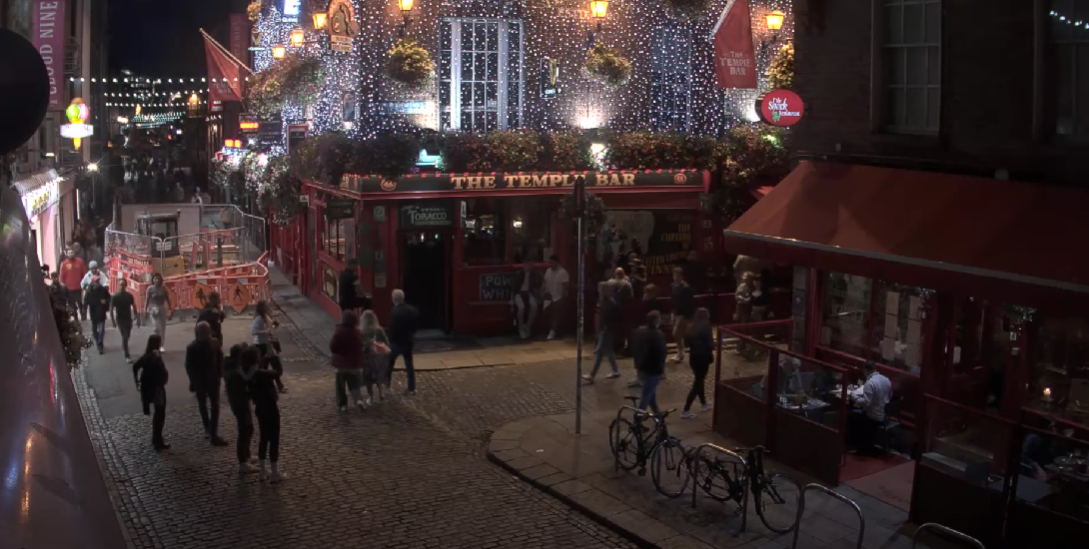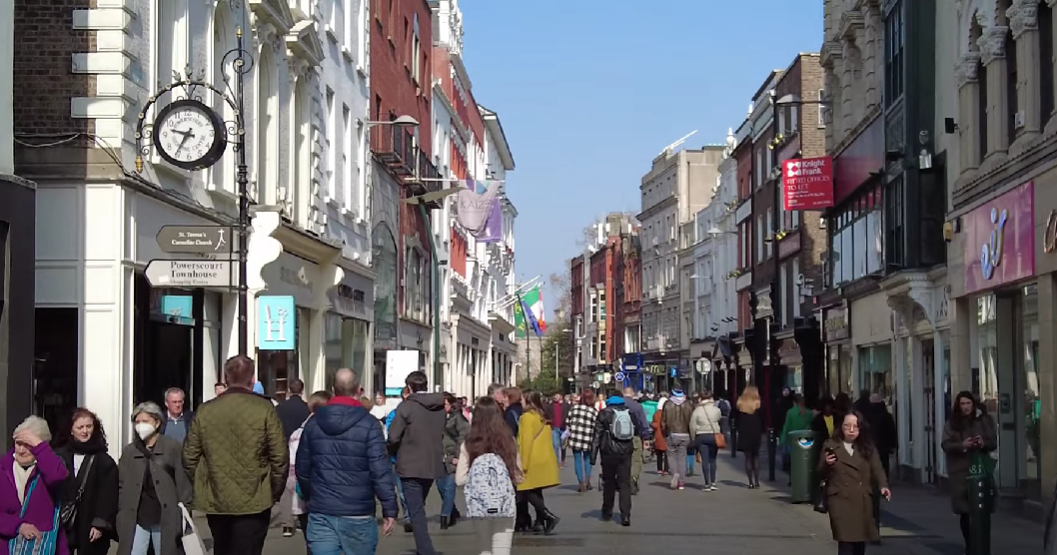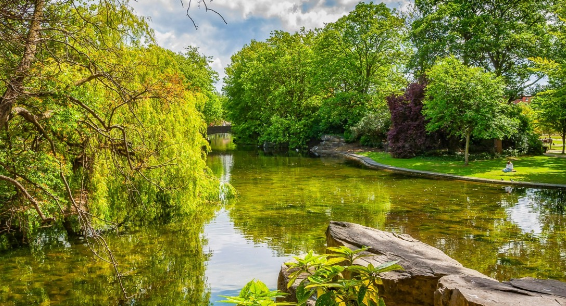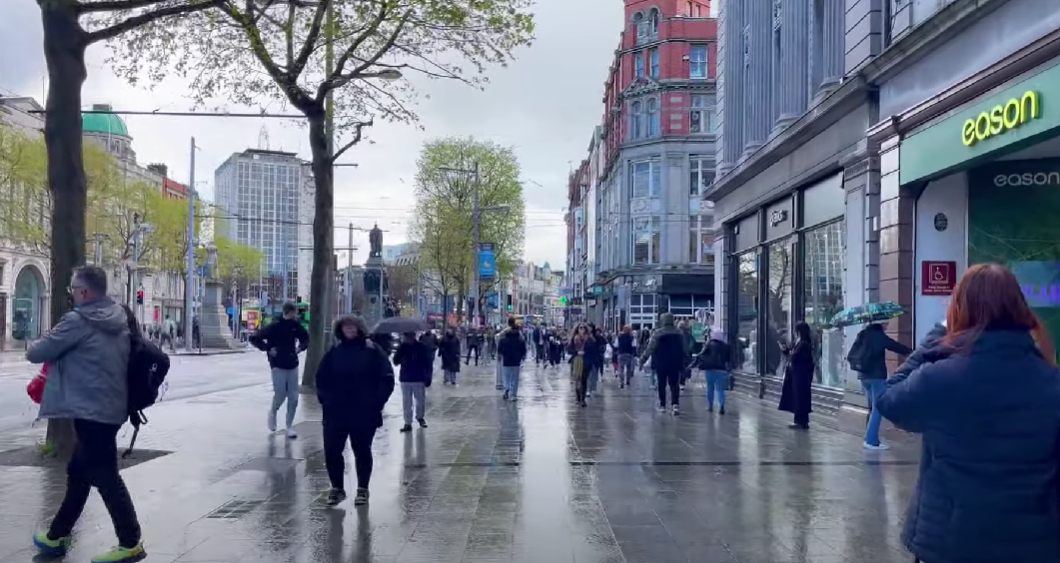Yes, Dublin is indeed a walkable city. Its compact size and pedestrian-friendly streets facilitate easy walking. Many attractions are closely located, making them accessible on foot. Public spaces and parks enhance the walking experience.

Source: Nina Near and Far
From my personal experience, strolling through Dublin has always been delightful. Walking from Trinity College to the Temple Bar area never gets old. Each journey uncovers something unique, from historic sites to lively street scenes. Dublin's walkable nature is truly a treasure for any visitor.
Is Dublin Walkable?
Yes, Dublin is quite walkable. The city features a compact urban core that invites pedestrians to explore its charming streets and historical landmarks on foot. Walking around Dublin allows you to fully experience the city's vibrant atmosphere and cultural richness.
During my last visit, I walked from Trinity College to Phoenix Park without any difficulty. The routes were well-signed, making navigation straightforward for visitors. Another time, I found myself strolling along the River Liffey; the scenic walk was both relaxing and picturesque.
Public transport complements the walkability of Dublin, with numerous bus stops and tram lines facilitating easy access to more distant attractions. This integration enhances the overall pedestrian experience, making it feasible to cover much of the city without relying on a car.
What Are the Most Walkable Areas in Dublin?
Dublin, with its compact city layout and rich historical architecture, is perfectly suited for pedestrians. The city's commitment to maintaining and enhancing its pedestrian zones ensures that residents and visitors alike can enjoy much of its charm on foot. From bustling shopping streets to tranquil parks, the walkable areas of Dublin are numerous, each offering a unique experience steeped in local culture and history.
The pedestrian-friendly design of Dublin not only supports an active lifestyle but also facilitates easy access to its plethora of attractions. These walkable areas are not just convenient but are vibrant hubs of activity where commerce, entertainment, and leisure intersect. Exploring and visiting these zones provides a deeper connection to the city’s rhythm and the essence of its community.
Temple Bar

Temple Bar stands out as the cultural heartbeat of Dublin, characterized by its lively atmosphere and artistic flair. This area of town is a haven for pedestrians, with its cobblestone streets mostly closed to vehicular traffic. It's a gathering place for locals and tourists alike who revel in its eclectic array of pubs, art galleries, and eateries. Each establishment in Temple Bar offers a unique glimpse into Dublin's vibrant cultural tapestry, often featuring live music that spills into the streets and complements the historic backdrop.
Moreover, Temple Bar is not just about leisure and entertainment. It also serves as a cultural hub, hosting regular markets where local artisans and farmers display their goods—ranging from handmade crafts to organic produce. This makes it a prime spot for those who appreciate the arts and enjoy immersing themselves in the local community. Additionally, the area is renowned for its cultural events and festivals, which transform the streets into a live canvas of performances, art installations, and culinary delights. Whether it's during the day or lit up at night, Temple Bar offers a dynamic and enriching experience for those who cherish a good stroll and a deep dive into the heart of south Dublin's cultural scene.
Grafton Street

As a flagship pedestrian zone, Grafton Street offers one of the finest shopping experiences in Dublin, completely free from vehicular disturbance. This bustling thoroughfare is lined with a wide array of retail stores, ranging from luxury designer boutiques to well-known high-street brands, ensuring that every shopper's taste and budget is catered to. In addition to its diverse shopping options, Grafton Street is also home to a variety of quaint cafes where visitors can pause for a coffee or a hearty meal.
The street atmosphere is further enriched by lively street performances that provide entertainment ranging from traditional Irish music to contemporary acts, creating a festive environment that captivates both locals and tourists alike. Throughout the year, Grafton Street is adorned with seasonal decorations and hosts a multitude of events, making it a picturesque and dynamic destination that encourages pedestrians to linger and enjoy for hours on end. Whether you're shopping for the latest fashion, enjoying a warm beverage, or simply soaking in the vibrant street life, Grafton Street offers a memorable and enjoyable pedestrian experience.
St. Stephen’s Green

St. Stephen’s Green is a cherished urban oasis, nestled in the heart of north Dublin, surrounded by a pedestrian-friendly area that enhances its accessibility and enjoyment. This iconic green space is a magnet for walkers, nature enthusiasts, and those seeking a peaceful retreat from the daily grind. Adjacent to the vibrant commercial activities of Grafton Street, the park offers a tranquil contrast with its meticulously landscaped gardens, winding pathways, and a scenic lake that serves as a focal point for visitors. The park's design features a variety of flora that bloom in different seasons, providing a constantly changing palette of colors and scents.
Throughout the park, there are numerous benches and quiet corners, making it an ideal spot for lunch breaks, reading, or simply enjoying a moment of solitude. The well-maintained lawns and shaded areas invite visitors to relax or engage in leisurely strolls, enjoying the soothing sounds of nature and occasional live performances from local artists. The historical significance of St. Stephen’s Green adds an educational element to visits, with various statues and memorials dotting the landscape, each telling a part of Dublin’s rich history. It’s not just a green space; it's a vibrant community hub where locals and tourists alike can immerse themselves in nature, culture, food, and tranquility, all within the bustling city environment.
O'Connell Street

O'Connell Street serves as a vivid showcase of Dublin's historical and modern landmarks, featuring expansive sidewalks that are ideal for pedestrian exploration. This bustling thoroughfare is not only a central hub of activity but also a living museum, lined with several significant statues and monuments that echo the rich narrative of Ireland’s past. Among these, of course the towering Spire of Dublin stands out, a contemporary symbol amidst the historical backdrop, piercing the city's skyline.
The street's strategic importance and aesthetic appeal make it a focal point for cultural events, including vibrant parades and public gatherings. These events, often steeped in tradition and festivity, further cement O'Connell Street’s role as a vital artery in the heart of Dublin, enhancing its status as one of the city’s most walkable and culturally significant areas. The blend of old and new, coupled with the lively atmosphere and architectural beauty, offers an immersive experience that encapsulates the essence of Dublin. Whether it's a leisurely stroll during a quiet morning or a walk through the energetic crowds during a festival, O’Connell Street offers a unique slice of Dublin life, making it a must-visit destination for anyone wanting to truly experience the city on foot.
How Accessible is Dublin for Pedestrians?
Dublin is recognized for its pedestrian-friendly environment. The city's design emphasizes walkability, especially in the central areas of cities where walking is often more convenient than driving. The flat terrain and well-maintained streets invite residents and tourists alike to explore on foot.
Many of Dublin’s cultural and historical attractions are easily accessible through walking routes that are both safe and scenic. This accessibility is bolstered by ongoing efforts to enhance the pedestrian experience:
-
Compact Layout: The heart of Dublin is dense and easy to navigate, making it practical to move from one point of interest to another without the need for public transport.
-
Pedestrian Zones: Areas like Grafton Street and Temple Bar are completely car-free, allowing pedestrians to roam freely without the interference of vehicular traffic.
Further enhancing the city centre's walkability, Dublin has invested in infrastructure that prioritizes pedestrians. Sidewalk improvements and expansions are common, ensuring there is ample space for pedestrians to walk, even in busier parts of the city.
Additionally, the integration of green spaces and public parks within urban areas provides pleasant and varied walking paths that are not only functional but also aesthetically pleasing. This commitment to maintaining and improving pedestrian routes ensures that Dublin remains a top city for walking enthusiasts.
How Does Public Transportation Complement Walkability in Dublin?
Public transportation significantly complements walkability in Dublin by offering extensive connectivity across the city. Dublin's well-integrated network includes buses, trams, and trains that link major pedestrian areas and tourist attractions effectively. This system allows residents and visitors to easily access different neighborhoods and key points of interest without a car. The availability of frequent and reliable public transit enhances the overall pedestrian experience, making Dublin more accessible and navigable.
Tips for Walking Around Dublin
Dublin is highly walkable, offering visitors and locals alike a pedestrian-friendly environment to explore its rich history and vibrant culture. The city's compact layout ensures that key attractions like Trinity College, St. Stephen's Green, and Temple Bar are easily accessible on foot. Moreover, Dublin's flat terrain and well-maintained sidewalks make it suitable for walkers of all ages.
Here are some tips for walking around Dublin:
-
Wear comfortable shoes as you’ll likely cover a lot of ground exploring the sights.
-
Stay prepared for Ireland’s unpredictable weather by carrying an umbrella or a raincoat.
-
Utilize the city’s comprehensive walking maps available at tourist centers to navigate efficiently.
-
Always stay aware of your surroundings, especially when crossing streets, as some areas can be busy with traffic.
-
Explore the pedestrian-only areas like Grafton Street and the surroundings of Dublin Castle for a more relaxed stroll.
Walking around Dublin not only offers a closer look at the city's historic architecture and lively street scenes but also provides an opportunity to interact with friendly locals. Sidewalk cafés and numerous pubs along the way offer perfect stops to rest and enjoy some local cuisine or a pint of Guinness. Embracing the city on foot exposes you to the hidden gems that vehicle-bound tourists might miss, making for a truly immersive Dublin experience.
What Are the Benefits of Exploring Dublin on Foot?
Exploring Dublin on foot provides numerous advantages. Walking through the city centre allows you to immerse yourself in its historic streets and vibrant culture more intimately than any other mode of transportation. Dublin is a very walkable city, and you can easily access its myriad attractions, from the storied doors of Georgian townhouses to the bustling stalls of Temple Bar. Engaging in a walking tour, you can visit Dublin's historic buildings and landmarks, enriching your experience with local stories and insights. Additionally, walking is beneficial for health, offering a chance to engage in light exercise while vacationing. Personally, strolling along the River Liffey at sunset has been one of my most cherished memories, giving me a serene appreciation of the city that I could not have experienced from a car.
If you arrive via Dublin Airport, you can conveniently take a Dublin Bus to reach the city centre. Once there, a walking tour can be a perfect start to your visit Dublin adventure. Additionally, walking is beneficial for health, offering a chance to engage in light exercise while vacationing. Exploring the Temple Bar pub area and other historic buildings by foot enhances your experience, as you can take in the vibrant atmosphere and cultural heritage up close. Personally, strolling along the River Liffey at sunset has been one of my most cherished memories, giving me a serene appreciation of the city that I could not have experienced from a car.
Historical and Cultural Immersion
Walking through Dublin allows for an up-close experience of its rich history and culture. On foot, you can observe architectural details and historical sites at your own pace. This slow travel approach enriches your understanding and appreciation of Dublin's heritage. Stroll through the cobbled streets of Temple Bar or visit the iconic St. Patrick’s Cathedral without the constraints of public transport schedules. Each step in Dublin is a step through history, with landmarks and stories waiting to be discovered around every corner.
Enhanced Health and Well-being
Exploring Dublin on foot is not only leisurely but also a healthy choice. Walking tours provide a structured way to enjoy this activity, offering a form of exercise that can improve cardiovascular health and boost mental well-being. Experiencing the city’s sights and sounds while walking tours contribute to a sense of relaxation and fulfillment. Regular walking reduces stress and anxiety, enhancing your travel experience. Additionally, navigating the city by foot can lead to unexpected discoveries, such as hidden cafes and unique local shops, adding to the overall enjoyment of your visit.
Economic and Environmental Benefits
Walking is both cost-effective and environmentally friendly. By exploring Dublin on foot, you save on transportation costs and contribute less to urban pollution. This sustainable way of touring the city helps preserve its charm for future generations. Moreover, walking reduces your carbon footprint, supporting Dublin’s efforts to become a greener city. As a pedestrian, you also contribute to the local economy more directly, often stopping at small businesses that are bypassed by those in vehicles.
FAQs On Is Dublin Walkable
1. Is Dublin walkable?
Yes, Dublin is highly walkable, especially in its city center where distances between major landmarks and amenities are short, and pedestrian zones are well-established.
2. What makes Dublin a walkable city?
Dublin offers extensive pedestrian pathways, reduced traffic zones, and abundant signage, making it safe and easy to navigate on foot. The city's compact layout contributes to its walkability.
3. Can tourists rely on walking as their main mode of transportation for tour around in Dublin?
Tourists can comfortably rely on walking to explore the main attractions in Dublin, as most are accessible by foot from the city center.
4. Are there any areas in Dublin that are less walkable?
While central Dublin is very walkable, some suburban areas might require the use of public transport or a car due to longer distances and fewer pedestrian pathways.
5. How does Dublin support pedestrians?
Dublin supports pedestrians through well-maintained sidewalks, controlled crossings, and dedicated pedestrian areas, enhancing safety and accessibility for all walkers.
